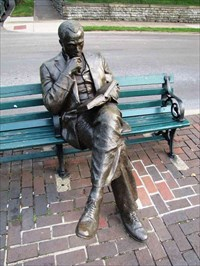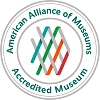James Bradley – from hopeless bondage to Lane Rebel
Thursday, September 5th, 2013by Ron Gorman, Oberlin Heritage Center volunteer docent
Seven years before the celebrated abolitionist Frederick Douglass first stood before a sympathetic audience of white abolitionists and “trembling in every limb” told them the story of his life as a slave, another ex-slave, James Bradley, stood before an audience of white colonizationists (people who believed freed slaves should be returned to Africa), and skillfully debunked the rationale of colonization and slavery. His presentation was part of a series of academic debates on abolitionism and colonization that would have an important impact on the American abolition movement and dramatically alter the course of Oberlin’s history.
James Bradley statue – Covington, KY
The debates were held at the Lane Seminary in Cincinnati, Ohio, in February, 1834 (see my William T. Allan – Lane Rebel from the South blog post for details). Of the approximately 45 total hours of debate time, James Bradley occupied about two hours, but an argument can be made that they were the two most important hours of the debates. Bradley started by telling his personal story, of being born in Africa, enslaved as a toddler, and brought across the Atlantic Ocean to South Carolina. Although we don’t have a transcript of his exact words at the debates, we do have a published account of his life story, written by him shortly afterwards. Here are some excerpts:
A slaveholder bought me and took me up into Pendleton County, Ky. I suppose I stayed with him about six months. He sold me to a Mr. Bradley, by whose name I have ever since been called. This man was considered a wonderfully kind master and it is true I was treated better than most of the slaves I knew. I never suffered for food and never was flogged with the whip but oh, my soul! I was tormented with kicks and knocks more than I can tell…
I used to work very hard. I was always obliged to be in the field by sunrise and labored until dark, stopping only at noon long enough to eat dinner. When I was about 15 years old, I took what was called the cold plague in consequence of being overworked and I was sick a long time. My master came to see me one day, and hearing me groan with pain, he said, “This fellow will never be of any more use to me. I would as soon knock him in the head, as if he were an opossum.” His children sometimes came in and shook axes and knives at me, as if they were about to knock me on the head…
My master kept me ignorant of everything he could. I was never told anything about God or my soul. Yet from the time I was 14 years old, I used to think a great deal about freedom. It was my heart’s desire. I could not keep it out of my mind. Many a sleepless night I have spent in tears because I was a slave. I looked back on all I had suffered and when I looked ahead, all was dark and hopeless bondage. My heart ached to feel within me the life of liberty.
After the death of my master I began to contrive how I might buy myself. After toiling all day for my mistress, I used to sleep three or four hours and then get up and work for myself the remainder of the night. I made collars for horses out of plaited husks. I could weave one in about eight hours and I generally took time enough from my sleep to make two collars in the course of a week. I sold them for 50 cents each. One summer, I tried to take two or three hours from my sleep every night, but I found that I grew weak and I was obliged to sleep more. With my first money, I bought a pig. The next year I earned for myself about $13 and the next, about $30…
I used to go out with my hoe and dig up little patches which I planted with corn…got up at night to tend it. My hogs were fattened with this corn and I used to sell a number every year. Besides this, I used to raise small patches of tobacco and sell it to buy more corn for my pigs. In this way I worked five years. At the end of which time, after taking out my losses, I found that I had earned $160. With this money I hired my own time for two years. During this period, I worked almost all the time, night and day. The hope of liberty stung my nerves and braced my soul so much that I could do with very little sleep or rest. I could do a great deal more work than I was ever able to do before. At the end of two years, I had earned $300 besides feeding and clothing myself. I now bought my time for 18 months longer and went 250 miles west, nearly into Texas, where I could make more money. Here I earned enough to buy myself, including what I gave for my time, about $700.
As soon as I was free, I started for a free state. When I arrived in Cincinnati, I heard of Lane Seminary, about two miles out of the city. I had for years been praying to God that my dark mind might see the light of knowledge. I asked for admission to the seminary. They pitied me and granted my request, though I knew nothing of the studies which were required for admission. I am so ignorant that I suppose it will take me two years to get up with the lowest class in the institution. But in all respects I am treated just as kindly and as much like a brother by the students, as if my skin were as white and my education as good as their own…[1]
Bradley also told how he secretly taught himself to read and write, against his masters’ wishes (and against the law in most Southern states). After telling his life story, Bradley went on to attack the concepts of slavery and colonization. This was a crucial time in the national abolition movement, when a large number of white Americans, even those who opposed slavery, believed that blacks couldn’t be integrated with whites in large numbers without a detrimental effect on both. This was one of the biggest arguments against abolition and in favor of colonization. At this point in time free blacks comprised less than 3% of the American population. Enslaved blacks, on the other hand, made up more than 34% of the population of the Southern states (and more than 50% of the population of South Carolina and Louisiana). The only knowledge many white Americans had of blacks came through the dehumanizing institution of slavery and the racial stereotypes that were used to rationalize it. In the words of South Carolina’s pro-slavery statesman John C. Calhoun:
“…two races differing so greatly, and in so many respects, cannot possibly exist together in the same country, where their numbers are nearly equal, without the one being subjected to the other. Experience has proved that the existing relation, in which the one is subjected to the other in the slaveholding States, is consistent with the peace and safety of both, with great improvement to the inferior…”[2]
Bradley’s mere presence at Lane Seminary, and the energy, ambition and hard work that brought him there, seriously challenged this philosophy. But Bradley had more to say, as described by Lane student Henry B. Stanton:
This shrewd and intelligent black, cut up these white objections by the roots, and withered and scorched them under the sun of sarcastic argumentation, for nearly an hour, to which the assembly responded in repeated and spontaneous roars of laughter, which were heartily joined in by both Colonizationists and Abolitionists. Do not understand me as saying, that his speech was devoid of argument. No. It contained sound logic, enforced by apt illustrations. I wish the slanderers of negro intellect could have witnessed this unpremeditated effort.
In response to the common argument that freed slaves would be unable to take care of themselves, Bradley said: “They have to take care of, and support themselves now, and their master, and his family into the bargain; and this being so, it would be strange if they could not provide for themselves, when disencumbered from this load.”[3]
In response to the common argument that the slaves were content with their position, we know him to have written: “How strange it is that anybody should believe any human being could be a slave and yet be contented. I do not believe there ever was a slave who did not long for liberty. I know very well that slave owners take a great deal of pains to make people in the free states believe that slaves are happy but I know likewise that I was never acquainted with a slave, however well he was treated, who did not long to be free.”[4]
I don’t think it’s an exaggeration to say that Bradley’s contribution was critical to the debates. Theodore Weld had the impassioned fervor and unassailable logic; William T. Allan and Huntington Lyman generated sympathy and outrage with their tales of victimization and abuse; but someone needed to attack the pervasive stereotypes and demonstrate that the John C. Calhouns were wrong. Only James Bradley could do that, and by all accounts he did it masterfully.
After the debates, Bradley became a manager of the newly formed student anti-slavery society, and when the school tried to squelch the students’ anti-slavery activities, he became one of the “Lane Rebels” who withdrew from the school in protest. When John J. Shipherd came down and invited the rebels to attend Oberlin College instead, Bradley was interested. But there was one hitch. Oberlin College at that time didn’t have a policy to admit black students. So the rebels demanded that such a policy be instated before they would come to Oberlin.
Shipherd, being a progressive member of the Western Reserve Anti-Slavery Society, was fine with this demand, but he needed the approval of the students, faculty and trustees of Oberlin College, and he expected he was in for some opposition. He wrote back to Oberlin: “Indeed, if our Board would violate right so as to reject youth of talent and piety because they were black, I should have no heart to labor for the upbuilding of our Seminary, believing that the curse of God would come upon us, as it has upon Lane Seminary, for its unchristian abuse of the poor slave.”[5]
Opposition he expected, and opposition he got. And then some. It was led by none other than his colony co-founder, Philo P. Stewart, who “at once proclaimed Bro. Shipherd Mad!! crazy etc. etc. and that the School was changed into a Negro School.” The Tappan brothers of New York offered generous financial support to the college, and the renowned revivalist minister Charles Finney offered to come to Oberlin and head a new Theological Department, if only the demands of the Lane Rebels were accepted. But this had little or no impact on the opponents. The college and the colony split on the issue and entered into several weeks of heated and sometimes acrimonious debate. Finally, with Shipherd threatening to depart “for another field of labor”, the college trustees voted by a narrow 5-4 margin to accept the demands of the rebels, and Oberlin College became the first college in the country to have a formal policy of race-blind admissions.[6]
With that the Lane Rebels, James Bradley included, came to Oberlin, as did two other notable African Americans, Charles and Gideon Langston (older brothers of John Mercer Langston). In fact so many students (the vast majority white), came to Oberlin over the next year that Oberlin College was forced to open four branch institutions in 1836 to handle the overflow. One of these was the Sheffield Manual Labor Institute in nearby Sheffield, which stressed agricultural manual labor and preparatory coursework. James Bradley transferred to this branch and attended along with about forty students, including the Langston brothers, James Fitch, Mary Hosford, and Mary Kellogg (future wife of future Oberlin College President James Fairchild).
Sheffield Manual Labor Institute at the Burrell Homestead
But things didn’t go well at Sheffield. Its agricultural experiments failed, and the school and many of its students faced financial difficulties. The crowning blow came when the school applied for a charter from the state of Ohio in 1837, and was told that it would only be granted if the school excluded black students. By this time the presence of James Bradley and the Langston brothers at Oberlin and Sheffield had allayed the community’s fears, with even Philo Stewart taking “his position with the foremost of Abolitionists”, so excluding black students from any Oberlin-affiliated school was unthinkable. (In fact, the Oberlin College campus was already openly harboring escaped slaves.) Consequently the Sheffield institute closed, with a few of the students returning to Oberlin, but most scattering to the wind. Unfortunately James Bradley was among the latter, and we have no record of him after leaving Sheffield.[7]
But even though we don’t know what happened to James Bradley, he clearly made his mark on Oberlin. His sheer indomitable will propelled him out of “dark and hopeless bondage” and to the Lane Seminary debate platform 7 years before Frederick Douglass, 9 years before Sojourner Truth and William Wells Brown, and 11 years before Lewis Clarke took the national stage. I can’t help but wonder what the results of the Lane debates might have been without him, and what the effect might have been on abolitionism and especially on the history of Oberlin. But I’ll have to leave those questions as food for thought, along with these closing words that James Bradley wrote in his letter to abolitionist Lydia Maria Child:
“God preserve you, and strengthen you in this holy cause, until the walls of prejudice are broken down, the chains burst in pieces, and men of every color meet at the feet of Jesus, speaking kind words, and looking upon each other in love – willing to live together on earth, as they hope to live in Heaven!” – James Bradley
Sources consulted:
Lydia Maria Child, The Oasis
Henry B. Stanton, “Great Debate at Lane Seminary”, letter to Joshua Leavitt, March 10, 1834
James Harris Fairchild, Oberlin: the colony and the college, 1833-1883
Robert Samuel Fletcher, A history of Oberlin College: from its foundation through the Civil War, Volume 1
“Sheffield Manual Labor Institute”, The Village Pioneer, March, 2008
“Marker #15-47 Burrell Homestead”, Ohio Historical Society
“Mr. Calhoun to Mr. Pakenham”, Proceedings of the Senate and Documents Relative to Texas, from which the Injunction of Secrecy Has Been Removed
“Catalogue and Record of Colored Students,” 1835-62, RG 5/4/3 – Minority Student Records, Oberlin College Archives
Historical Census Browser, Census Data for Year 1830, University of Virginia Library
“Statue story of freedom”, Cincinnati.com
“James Bradley – Covington, Kentucky”, Waymarking.com
Delazon Smith, A History of Oberlin
“General catalogue of Oberlin college, 1833 [-] 1908″, Oberlin College Archives
FOOTNOTES:
[1] Child, pp. 106-107
[2] “Mr. Calhoun to Mr. Pakenham”
[3] Stanton, March 10, 1834
[4] Child, pp. 110-111
[5] Fairchild, p. 55
[6] Fletcher, Chapter XIV; Fairchild, p. 61
[7] “Sheffield Manual Labor Institute”; Fairchild p. 63; “General catalogue”; Smith, pp. 63-64








